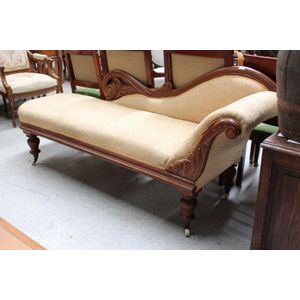19th Century Cedar Miners Couch with Rolling Pin Crest
Antique mid 19th century Australian cedar miners couch, shaped back board with turned rolling pin crest
You must be a subscriber, and be logged in to view price and dealer details.
Subscribe Now to view actual auction price for this item
When you subscribe, you have the option of setting the currency in which to display prices to $Au, $US, $NZ or Stg.
This item has been sold, and the description, image and price are for reference purposes only.
- Back Boards - As the name implies, the boards that back a piece of cabinet furniture such as a chest of drawers. The backing timber is usually of cheaper material like pine (often called 'deal' by the British trade), though in early Australian colonial days, red cedar was also used to back a piece. As cedar became scarcer during the later 19th century, craftsmen turned to kauri pine.
On early furniture, made before the first half of the 19th century, the backboards were often chamfered at the edges and the wide boards slotted into grooves in a supporting central frame. In later furniture, the backboards were generally nailed or screwed into rebates cut directly into the carcase and the boards became much thinner and narrower.
From about the first world war plywood was frequently used for cheaper pieces.
Backboards are one important way of judging the age of a piece of furniture. - Turning - Any part of a piece of furniture that has been turned and shaped with chisels on a lathe. Turned sections include legs, columns, feet, finials, pedestals, stretchers, spindles etc. There have been many varieties and fashions over the centuries: baluster, melon, barley-sugar, bobbin, cotton-reel, rope-twist, and so on. Split turning implies a turned section that has been cut in half lengthwise and applied to a cabinet front as a false decorative support.
- Rolling Pin - A decorative ornament often found on Australian colonial furniture mainly from the second half of the 19th century. It consists of a turned piece of timber, perhaps 45 cm long, with small turned finials at either end. It is used, for example, to surmount the shaped backs of some miner's couches or four-poster beds.
This item has been included into following indexes:
Visually similar items

Antique Cedar single end chaise lounge, standing on turning tapering legs, approx 190 cm long
Sold by
in
for
You can display prices in $Au, $US, $NZ or Stg.

Australian Colonial cedar miner's couch with cushion seat and bolster ends C.1870
Sold by
in
for
You can display prices in $Au, $US, $NZ or Stg.

Antique French inlaid walnut bed, 144.5 cm wide, 200 cm long, 141 cm high, to take a mattress 140 x 185 cm
Sold by
in
for
You can display prices in $Au, $US, $NZ or Stg.

Colonial cedar settle double ended sofa, 205 cm wide
Sold by
in
for
You can display prices in $Au, $US, $NZ or Stg.
